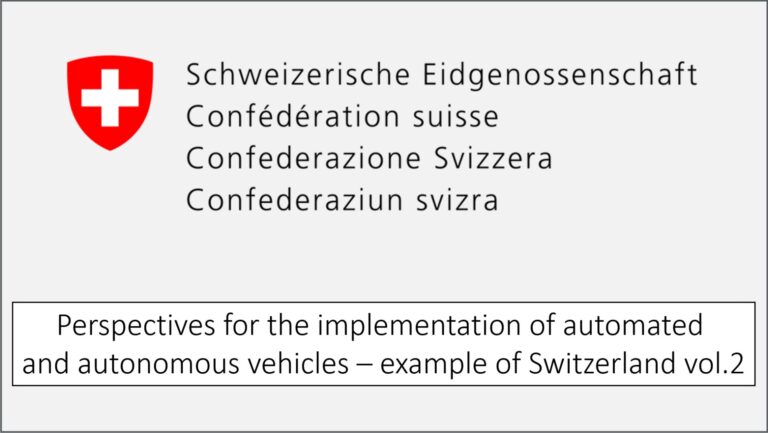Blog
Requirements for test drives of automated vehicles in road traffic in Switzerland
Authorized testing of automated vehicles was allowed in Switzerland in 2015. Currently, permits for tests (only with the participation of the driver) are issued by the Federal Department of the Environment, Transport, Energy and Communications (DETEC). As part of the amendment to the Road Traffic Act, on March 17, 2023, the Swiss Parliament granted the Federal Roads Office (FEDRO) the authority to issue permits for test drives of automated vehicles in road traffic.
A permit for test drives of automated vehicles in road traffic is required in the following situations:
- if the normal registration procedure is not possible;
- when during the tests it is allowed to disregard certain legal provisions, while maintaining road safety (safety must be guaranteed throughout the tests).
Authorities require accurate test reports
Currently, one of the main reasons for issuing a special permit to perform test drives in Switzerland is to obtain, through testing, new information regarding the state of technology or the use of automated vehicles and systems. Applicants are required to explain how legal provisions that cannot be met during the test are to be compensated by implementing appropriate measures. A permit can only be issued if the federal agency determines that the risks associated with road testing are at a safe level.
The special authorization will only be granted if the organizers of the road tests of automated vehicles allow the Federal Roads Office full access to all test data if this proves necessary to evaluate the test and draw appropriate conclusions. FEDRO may appoint experts for this purpose, respecting the commercial secrets of the organizer of automatic vehicle tests.
Successfully completed tests of an automated vehicle may be an important factor in obtaining an individual permit to register such a vehicle in the normal course
Tests of automated vehicles in road traffic are the basis for the subsequent admission of vehicles to traffic, but they can also provide valuable information and insights in the field of transport automation and promote a particular country, e.g. Switzerland, as an attractive location for developing a business or conducting research. The implementation of new technologies opens up many opportunities for the national transport system.
Requirements for issuing permits:
a. Vehicle technology
Automated vehicles used in the test must meet the same requirements as conventional vehicles. This applies to brakes, lights, maximum speed, electrical safety, etc. Moreover – also in automated mode – it must be possible for the operator to disable or take over control of the system, e.g. to activate the vehicle’s brakes or respond to vehicle movement in a traditional way.
In order for the applicant to meet these requirements, he or she must have the necessary knowledge in the construction of such vehicles.
Automated vehicles and type approval requirements
Automated vehicles must (in principle) be type-approved. The type-approval procedure is set out in Regulation (EU) 2018/858. As part of the type-approval process for an autonomous vehicle, it must be demonstrated that the detailed requirements of Regulation (EU) 2019/2144 and Implementing Regulation (EU) 2022/1426 have been met, including the provisions contained in UN-R155, i.e. CSMS (Cyber security and cyber security management system) and R156 – SUMS (Software update and software update management system) and ISMR (In-Service Monitoring and Reporting). . Type approval must be obtained from an EU Member State (or from a Member State of the 1958 Agreement) and must also cover Switzerland.
Automated vehicles with a separate, individual permit (without type approval)
In Switzerland, the Federal Roads Office (FEDRO) is authorized to approve Automatic Driving Systems (ADS) in automated vehicles that are not type-approved. Applicants must in each case demonstrate that the specified level of safety is guaranteed in the vehicle and must provide a detailed description of the ODD (operating design conditions). The level of safety must be equal to that guaranteed in the type-approval procedure.
With a separate, individual ADS authorization, the vehicle can finally be registered under the normal procedure and can be used commercially.
b. Security
When testing an automated vehicle on the road, safety should be given the highest priority. This applies to the safety of other road users as well as the people in the vehicle.
Currently, the same insurance regulations apply to automated vehicles used (including in tests) on Swiss roads as for regular vehicles:
- To register a vehicle, the vehicle owner must purchase third party liability insurance covering damage caused by the vehicle.
- Parties who have suffered damage have the right to pursue claims directly against the insurer under contractual insurance coverage.
- In certain circumstances, the insurer has the right of recourse against the party that caused the damage.
c. Operation
Vehicle operation is limited to specific circuits and routes, with the consent of the relevant road owners. The maneuvers to be performed by the vehicle must be clearly described. In retrospect, it must be possible to determine when the vehicle was operated in automated mode and whether the person accompanying the test took control of it. In addition, you must keep a travel diary in which you must record details of your journey (distance in kilometers, date, time and any events that may have occurred).
Automated vehicle testing area
The automated vehicle testing area must be approved before the registration procedure. May include highways, urban and rural areas. Automated vehicles can only drive on specific routes, but the authorization does not have to be limited to a few streets. It can even cover a large number of routes or even all routes in a specific area. Applicants must evaluate and confirm that all routes they apply for are within the operating limits of the ADS and that permitting requirements have been met. Restrictions in the desired operational area may be due to ODD or the vehicle owner’s operational concept.
Assessment of the automated vehicle testing area
Authorization requirements:
- vehicles must be able to move independently within the operational area,
- the infrastructure on a given route must meet the technical requirements for the operation of automated vehicles.
- the operation of automated vehicles must not disrupt traffic or cause traffic congestion,
- there must be no threat to road safety,
- all duties of a regular driver must still be fulfilled,
- the vehicle’s behavior is supervised by suitably qualified operators who have access to the required data and information about the vehicle’s operation at all times and have appropriately equipped workstations,
- the operator can supervise several vehicles at the same time and does not have to be close to the vehicle, but his workplace must be in Switzerland,
- communication between operators and passengers in the vehicle is ensured at all times via an audiovisual interface,
- if necessary, the authority may specify additional requirements due to local conditions (e.g. relatively slow vehicles may only operate outside peak hours, etc.).
d. Carriage of passengers
If the test of an automated vehicle is to involve the transportation of passengers, the appropriate license must generally be obtained from the Federal Office of Transport (FOT).
e. Training
Evidence must be provided that all personnel involved in the testing have received the necessary training.
f. The role of the authorities and the police
The cantonal authorities (Switzerland is a federal state, divided into cantons that have the character of state organisms) are responsible for issuing the license plate of the vehicle to be used during the test, but not for issuing a permit to carry out the test. The relevant agency (e.g. road traffic authority) is involved in checking the vehicle technology for the test.
In addition, the relevant road owners (federal authority, canton, municipality/city or, if necessary, private individuals) must be involved in determining which road sections can be used for the test. Moreover, due to their comprehensive knowledge of the local area and their role as law enforcement agencies, the cantonal and local authorities and the police should also be involved in the research.
g. Data protection
An automated vehicle cannot operate without transmitting and exchanging data. Leaks and false data have a direct impact on the safety of road users and passengers. Data security is therefore of the utmost importance.
h. Radio communication permit
Automated vehicles require a wide range of electronic devices and wireless transmission technologies that have the potential to interfere with other radio communication devices and electrical devices. Therefore, it is necessary to ensure interference-free transmission.
Source:
Regulating automated driving in Switzerland, Informal document GRVA-18-13 submitted by the expert of Switzerland – Armin Jost, 18th GRVA, 22-26 stycznia 2024
Automated driving. Fact sheet for conducting pilot tests in Switzerland, Federal Roads Office (FEDRO) Information and Communication Section, Federal Department of the Environment, Transport, Energy and Communications (DETEC), Version 4.0, 25.10.2022.


